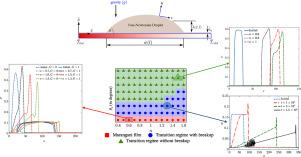On the combined role of gravity and rheology in thermocapillary-driven droplet spreading
IF 3.9
3区 工程技术
Q2 ENGINEERING, CHEMICAL
引用次数: 0
Abstract
The complex rheology of biofluids and industrial fluids is a decisive factor in their deformation and spreading on a heated substrate. However, the intervening role of gravity forces remains unexplored. Here, we apply the lubrication approximation to the momentum equation and the power-law constitutive relation for inelastic non-Newtonian fluids, with the intermolecular forces being accounted for within the continuum hypothesis. The derived evolution equation for droplet height has been solved numerically using the finite element method. The Marangoni stress dominates the conjoining–disjoining pressure in the ‘Marangoni film regime’. The gravity effect causes a significant curvature of the rear edge, leading to a pancake-like droplet shape and reduced capillary ridge height near advancing fronts. Furthermore, increasing capillary ridge height with shear-thinning and faster-moving advancing fronts with either enhanced Marangoni stress or shear-thickening are both dampened by gravity. The droplet regime, previously observed in microgravity conditions, no longer exists under gravity. The drop deviates from its initial shape as dictated by its rheology but maintains the same shape afterwards, leading to a new regime named ‘transition without breakup.’ The gravity effect weakens after initial deformation, and the dominant conjoining–disjoining pressure results in a constant migration speed without further deformation. The ‘transition with breakup regime’, where droplets break apart into smaller droplets, is influenced by a critical interaction between Marangoni stress, intermolecular force, and gravity force. The onset of rupture strongly depends on the fluid rheology and the thermocapillary strength. The presented regime maps provide the critical parameters for switching regimes and highlight exclusive spreading states under gravity. These insights on the critical interaction between gravity, shear-dependent rheology, and thermocapillary actuation for partially wetting droplets could lead to more versatile microfluidic devices for handling complex biofluids.

重力和流变在热毛细管驱动液滴扩散中的联合作用
生物流体和工业流体的复杂流变学是它们在加热基底上变形和扩散的决定性因素。然而,重力的介入作用仍未被探索。在这里,我们将润滑近似应用于非弹性非牛顿流体的动量方程和幂律本构关系,并在连续介质假设中考虑分子间力。利用有限元法对推导的液滴高度演化方程进行了数值求解。在“马兰戈尼薄膜体系”中,马兰戈尼应力主导着连接-分离压力。重力效应导致后缘明显弯曲,导致在推进锋面附近形成煎饼状液滴形状并降低毛细脊高度。此外,毛细脊高度的增加与剪切减薄以及锋面快速移动与马兰戈尼应力增强或剪切增厚都受到重力的抑制。以前在微重力条件下观察到的液滴状态在重力下不再存在。由于其流变性,液滴偏离了其初始形状,但随后保持了相同的形状,从而形成了一种名为“过渡而不破裂”的新状态。初始变形后,重力作用减弱,主要的连接-分离压力导致运移速度恒定,不会进一步变形。在“破裂过渡状态”中,液滴分裂成更小的液滴,受到马兰戈尼应力、分子间力和重力之间的关键相互作用的影响。破裂的发生在很大程度上取决于流体流变学和热毛细强度。所提出的状态映射提供了切换状态的关键参数,并突出了重力作用下的独占扩展状态。这些关于重力、剪切依赖流变学和部分湿润液滴热毛细管驱动之间关键相互作用的见解,可能会导致更多功能的微流体装置用于处理复杂的生物流体。
本文章由计算机程序翻译,如有差异,请以英文原文为准。
求助全文
约1分钟内获得全文
求助全文
来源期刊

Chemical Engineering Research & Design
工程技术-工程:化工
CiteScore
6.10
自引率
7.70%
发文量
623
审稿时长
42 days
期刊介绍:
ChERD aims to be the principal international journal for publication of high quality, original papers in chemical engineering.
Papers showing how research results can be used in chemical engineering design, and accounts of experimental or theoretical research work bringing new perspectives to established principles, highlighting unsolved problems or indicating directions for future research, are particularly welcome. Contributions that deal with new developments in plant or processes and that can be given quantitative expression are encouraged. The journal is especially interested in papers that extend the boundaries of traditional chemical engineering.
 求助内容:
求助内容: 应助结果提醒方式:
应助结果提醒方式:


